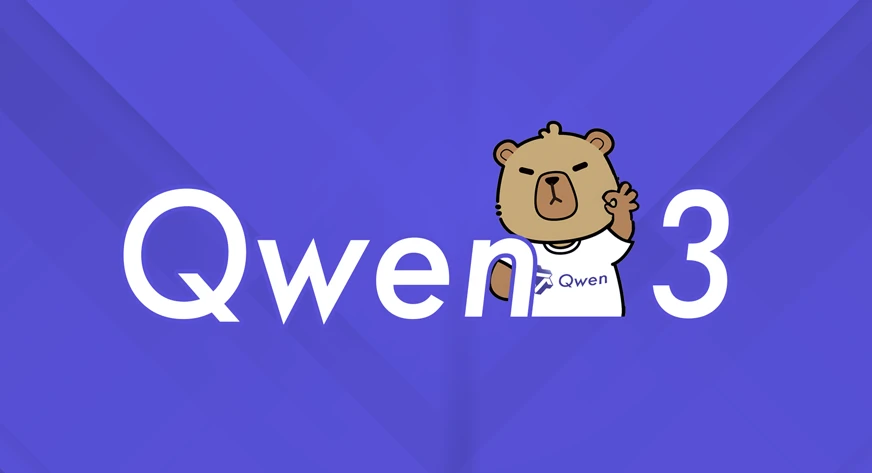Two new Qwen fashions got here out not too long ago – the Qwen3-4B-Instruct-2507 and Qwen3-4B-Pondering-2507. Each Qwen3 fashions have context size of 256K, and realizing this, I assumed to myself, “Why not make a RAG to make good use of the context size?”. It’s value mentioning that the Qwen3 household has a big number of fashions meant for coding, considering, embedding, and reranking. Right here, to make our RAG in the absolute best means, we’ll use Qwen3’s embedding mannequin and reranker mannequin.
Don’t fear, we gained’t begin off by constructing the RAG! We’ll first individually take a look at these fashions after which construct the RAG.
Qwen3 fashions: Background
Developed by Alibaba Cloud, a number of Qwen3 fashions have been launched a couple of months again. As an enchancment to those fashions, two new fashions, Qwen3-Instruct-2507 and Qwen3-Pondering-2507, have been not too long ago launched in three sizes: 235B-A22B, 30B-A3B, and 4B. Be aware that we’ll be primarily specializing in the ‘Qwen3-Instruct-2507’ 4B variant for this text. All these fashions are open-source and are available on Hugging Face and Kaggle. It’s additionally value mentioning that the Qwen3 fashions have multilingual help, extra particularly, 119 languages and dialects. Let’s see a couple of of the Qwen3 fashions in motion, and later construct the RAG we’re right here for.
Qwen3 Fashions Demo
Let’s begin with the textual content technology mannequin, however earlier than that, make certain to get your Hugging Face entry token from right here.
Be aware: We’ll be doing this demo on Google Colab. After opening a brand new pocket book, make certain so as to add the entry token as HF_TOKEN within the secrets and techniques tab on the left. Be certain to activate entry to the pocket book.
Qwen3-4B-Instruct-2507
That is an up to date model of the Qwen3-4B non-thinking mode and has a meaty context size of 256k. As you possibly can inform from the identify itself, this mannequin has 4 billion parameters, which is comparatively gentle and appropriate to make use of on Colab. Let’s fireplace up this mannequin utilizing Hugging Face transformers and see it in motion.
Be aware: Change the runtime sort to T4 GPU to deal with the mannequin.
# Setup and Dependencies
import torch
import torch.nn.purposeful as F
from transformers import AutoModelForCausalLM, AutoTokenizer, AutoModel# Instruct Mannequin (Textual content Era)
tokenizer = AutoTokenizer.from_pretrained("Qwen/Qwen3-4B-Instruct-2507")
mannequin = AutoModelForCausalLM.from_pretrained(
"Qwen/Qwen3-4B-Instruct-2507",
torch_dtype="auto",
device_map="auto"
)
immediate = "Clarify what machine studying is in easy phrases."
messages = [{"role": "user", "content": prompt}]
textual content = tokenizer.apply_chat_template(
messages,
tokenize=False,
add_generation_prompt=True,
enable_thinking=False
)
model_inputs = tokenizer([text], return_tensors="pt").to(mannequin.gadget)
generated_ids = mannequin.generate(
**model_inputs,
max_new_tokens=256
)
output_ids = generated_ids[0][len(model_inputs.input_ids[0]):].tolist()
response = tokenizer.decode(output_ids, skip_special_tokens=True)
print(response)Right here’s the output I bought for my query on “Clarify what machine studying is in easy phrases.” :
Certain! In easy phrases, **machine studying** is a means for computer systems to be taught from information and enhance at doing duties with out being explicitly programmed to take action.
Think about you've a robotic that learns to acknowledge cats in pictures. As a substitute of writing step-by-step directions like "search for a spherical face, massive eyes, and a nostril," you simply present it many photos of cats and photos of canine. Over time, the robotic begins to determine what makes a cat totally different from a canine — it learns by itself by means of examples.
That’s machine studying: the pc seems to be at information (like photos, numbers, or textual content), finds patterns, and will get higher at making predictions or choices primarily based on these patterns.
Consider it like how a toddler learns to establish totally different animals by seeing them again and again. The machine does one thing comparable — it learns from expertise (information) and will get smarter with time.
So, briefly:
**Machine studying = educating computer systems to be taught from information and enhance on their very own.** 😊Qwen3-Embedding-0.6B
That is an embedding mannequin used to transform textual content to dense vector representations to grasp the connection between texts. That is a necessary a part of the RAG that we’ll be constructing later. The embedding mannequin varieties the guts of the Retriever in Retrieval Augmented Era (RAG).
Let’s outline a perform for reusability and discover the embedding to seek out the similarity between the texts. I’m passing 4 strings (textual content) within the ‘texts’ record.
# Qwen3-Embedding-0.6B (Textual content Embeddings)
def last_token_pool(last_hidden_states, attention_mask):
left_padding = (attention_mask[:, -1].sum() == attention_mask.form[0])
if left_padding:
return last_hidden_states[:, -1]
else:
sequence_lengths = attention_mask.sum(dim=1) - 1
batch_size = last_hidden_states.form[0]
return last_hidden_states[torch.arange(batch_size, device=last_hidden_states.device), sequence_lengths]
tokenizer = AutoTokenizer.from_pretrained('Qwen/Qwen3-Embedding-0.6B', padding_side="left")
mannequin = AutoModel.from_pretrained('Qwen/Qwen3-Embedding-0.6B')
texts = [
"Machine learning is a subset of artificial intelligence.",
"Python is a popular programming language.",
"The weather is sunny today.",
"Artificial intelligence is transforming industries."
]
batch_dict = tokenizer(
texts,
padding=True,
truncation=True,
max_length=8192,
return_tensors="pt",
)
outputs = mannequin(**batch_dict)
embeddings = last_token_pool(outputs.last_hidden_state, batch_dict['attention_mask'])
embeddings = F.normalize(embeddings, p=2, dim=1)
scores = (embeddings @ embeddings.T)
print(scores.tolist())Output:
[[1.0, 0.4834885597229004, 0.3609130382537842, 0.6805511713027954], [0.4834885597229004, 1.0000001192092896, 0.44289979338645935, 0.4494439363479614], [0.3609130382537842, 0.44289979338645935, 1.0000001192092896, 0.4508340656757355], [0.6805511713027954, 0.4494439363479614, 0.4508340656757355, 1.0]]This can be a matrix we calculated by discovering the similarity scores of texts with one another. Let’s simply take a look at the first row of the matrix for simpler understanding. As you possibly can see, the similarity of the identical texts is all the time 1, the subsequent fast highest is 0.68, which is between a sentence about AI and a sentence about ML, and the similarity between an announcement about climate and AI will not be very excessive, which is smart.
Qwen3-Reranker-0.6B
We are able to move the retrieved chunks that may be obtained by vector search utilizing the embedding mannequin. The reranker mannequin scores every chunk towards the question to order the record of paperwork and assign precedence, or use these scores to subset the retrieved chunks. We’ll see this mannequin instantly in motion within the upcoming part for higher understanding.
Constructing A RAG utilizing the Qwen fashions
We’ll construct a RAG on Analytics Vidhya Blogs (~ 40 blogs) utilizing the three specified Qwen3 fashions. We’ll sequentially course of the information and use the fashions. For environment friendly processing, we’ll be loading/unloading the mannequin for utilization to protect reminiscence. Let’s take a look at the steps and dive into the script.
- Step 1: Obtain the information. Right here’s the hyperlink to my repository the place you’ll find the information and the scripts.
- Step 2: Set up the necessities:
!pip set up faiss-cpu PyPDF2 - Step 3: Unzip the information right into a folder:
!unzip Knowledge.zip - Step 4: For simpler execution, you possibly can simply add the qwen_rag.py script within the Colab atmosphere and run the script utilizing:
! python qwen_rag.py
Breaking down the script:
- We’re utilizing the PYPDF2 library to load the content material of the articles in PDF format. A perform is outlined to learn weblog content material in .txt or .pdf codecs.
- We’re chunking the content material into chunks of measurement 800 and an overlap of 100 to keep up context relevancy in consecutive paperwork.
- We’re utilizing FAISS to create a vector retailer, and with the assistance of our question, we’re retrieving top-15 paperwork primarily based on similarity.
- Now we use the reranker on these 15 paperwork to get the top-3 through the use of this perform:
def rerank_documents(question, candidates, k_rerank=3):
"""Rerank paperwork utilizing reranker mannequin"""
print("Reranking paperwork...")
tokenizer, mannequin = load_reranker_model()
# Put together inputs
pairs = []
for doc, _ in candidates:
pair = f": Given an internet search question, retrieve related passages that reply the queryn: {question}n: {doc['content']}"
pairs.append(pair)
# Tokenize
inputs = tokenizer(pairs, padding=True, truncation=True, max_length=8192, return_tensors="pt").to(gadget)
# Get scores
with torch.no_grad():
outputs = mannequin(**inputs)
logits = outputs.logits[:, -1, :]
# Get sure/no token scores
token_false_id = tokenizer.convert_tokens_to_ids("no")
token_true_id = tokenizer.convert_tokens_to_ids("sure")
true_scores = logits[:, token_true_id]
false_scores = logits[:, token_false_id]
batch_scores = torch.stack([false_scores, true_scores], dim=1)
batch_scores = torch.nn.purposeful.log_softmax(batch_scores, dim=1)
scores = batch_scores[:, 1].exp().tolist()
# Unload reranker mannequin
del tokenizer, mannequin
clear_memory()
print("Reranker mannequin unloaded")
# Type by rating
paperwork = [doc for doc, _ in candidates]
doc_scores = record(zip(paperwork, scores))
doc_scores.kind(key=lambda x: x[1], reverse=True)
return doc_scores[:k_rerank] - As soon as we’ve these 3 prime paperwork, we move them to the instruct mannequin to get our last output from the Retrieval Augmented Generator.
Output:
Query: What's the distinction between LoRA and QLoRA?
Reply: LoRA (Low-Rank Adaptation) and QLoRA (Quantized Low-Rank Adaptation) are each parameter-efficient fine-tuning strategies used to adapt giant language fashions (LLMs) to particular duties. Whereas they share similarities, they differ of their strategy and effectivity.
1. **LoRA (Low-Rank Adaptation)**:
- LoRA introduces low-rank matrices (A and B) into the self-attention module of every layer within the pre-trained mannequin. These matrices act as adapters that permit the mannequin to adapt and specialize for particular duties whereas minimizing the variety of further parameters wanted.
- LoRA reduces parameter overhead by specializing in optimizing trainable low-rank matrices as an alternative of fine-tuning all parameters. This makes it rather more memory-efficient and computationally cheaper.
- LoRA permits the pre-trained mannequin to be shared throughout a number of duties, facilitating environment friendly task-switching throughout deployment.
- LoRA doesn't introduce any further inference latency in comparison with totally fine-tuned fashions, making it appropriate for real-time purposes.
2. **QLoRA (Quantized Low-Rank Adaptation)**:
- QLoRA is an extension of LoRA that additional introduces quantization to reinforce parameter effectivity throughout fine-tuning. It builds on the ideas of LoRA whereas introducing 4-bit NormalFloat (NF4) quantization and Double Quantization strategies.
- NF4 quantization leverages the inherent distribution of pre-trained neural community weights, remodeling all weights to a hard and fast distribution that matches throughout the vary of NF4 (-1 to 1). This enables for efficient quantization with out the necessity for costly quantile estimation algorithms.
- Double Quantization addresses the reminiscence overhead of quantization constants by quantizing the quantization constants themselves. This considerably reduces the reminiscence footprint with out compromising efficiency.
- QLoRA achieves even increased reminiscence effectivity by introducing quantization, making it significantly useful for deploying giant fashions on resource-constrained gadgets.
- Regardless of its parameter-efficient nature, QLoRA retains excessive mannequin high quality, acting on par and even higher than totally fine-tuned fashions on numerous downstream duties.
In abstract, whereas LoRA focuses on lowering the variety of trainable parameters by means of low-rank adaptation, QLoRA additional enhances this effectivity by incorporating quantization strategies, making it extra appropriate for deployment on gadgets with restricted computational assets.
Sources: fine_tuning.txt, Parameter-Environment friendly Fantastic-Tuning of Giant Language Fashions with LoRA and QLoRA.pdf, Parameter-Environment friendly Fantastic-Tuning of Giant Language Fashions with LoRA and QLoRA.pdfBe aware: You may check with the log file ‘rag_retrieval_log.txt’ to get extra details about the paperwork retrieved and the similarity rating with the question and the reranker scores.
Conclusion
By combining Qwen3’s instruct, embedding, and reranker fashions, we’ve constructed a sensible RAG pipeline that makes full use of their strengths. With 256K context size and multilingual help, the Qwen household proves versatile for real-world duties. For subsequent steps, you can attempt growing the paperwork handed to the instruct mannequin or use a considering mannequin for a special use case. The outputs additionally appear promising. I recommend you attempt evaluating the RAG on metrics like Faithfulness and Reply Relevancy to make sure the LLM is generally freed from hallucinations in your job/use-case.
Incessantly Requested Questions
Chunking is the method of splitting giant textual content into smaller overlapping segments to keep up context whereas enabling environment friendly retrieval.
A vector retailer is a database that shops textual content embeddings for quick similarity search and retrieval.
You may consider a RAG utilizing metrics like accuracy, relevance, and response consistency throughout totally different queries.
It will depend on your context size restrict; sometimes, 3–5 top-ranked paperwork work nicely.
A reranker scores retrieved paperwork towards a question to reorder them by relevance earlier than passing to the LLM.
Login to proceed studying and luxuriate in expert-curated content material.

